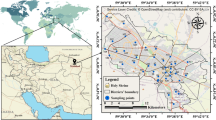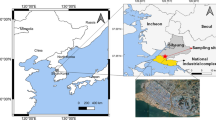Abstract
Polycyclic aromatic hydrocarbons (PAHs) were measured in airborne particulate matter (PM) collected by an eight-stage (S0, S1, …, S7, and SF) particle sizing sampler in three sampling periods, 85 h (85-h) each period. The measured particle-phase PAHs (P-only) data set and the sum of predicted gas-phase and measured particle phase PAHs (predicted G + P) data set considering the effect of gas/particle partitioning were used in positive matrix factorization (PMF) for source apportionment. Benzo[a]pyrene equivalent concentration (BaPeq) and incremental life cancer risk (ILCR) model were utilized for risk assessment of PAHs. The average concentrations of 85-h PM10 and PM2.1 were 292.729 and 142.642 μg/m3, respectively. The average concentration of 15 PAHs was 480.777 ng/m3 in PM10 and 254.464 ng/m3 in PM2.1. PAHs showed unimodal distribution among the nine sampling stages and S5 collected the most concentrations of PAHs and PM. PAHs with over four aromatic rings tended to accumulate in fine PM especially in S5 and S6 while PAHs with less than four rings preferred to stay in coarse PM especially in S0. A four source profiles for P-only were identified by PMF as follows with their source contributions: biomass burning (BB) (9.580 %), coal combustion (CC) (10.600 %), “air-surface exchange” (20.160 %), and vehicle emission (VE) (59.660 %). However, three source profiles for predicted G + P only identified including BB (93.330 %), CC (0.0600 %), and VE (6.610 %). The average 85-h average total BaPeq of 15 PAHs was 5.226 g/m3. S4, S5, and S6 had BaPeq concentrations greater than domestic standard concentration and ILCR value higher than 10−6.







Similar content being viewed by others
References
Agarwal, T. (2009). Concentration level, pattern and toxic potential of PAHs in traffic soil of Delhi, India. Journal of Hazardous Materials, 171(1–3), 894–900.
Agency, U. S. E. P. (2014). EPA Positive Matrix Factorization (PMF) 5.0 Fundamentals and User Guide NC 27711. Research Trianle Park: National Exposure Research Laboratory.
Alghamdi, M. A., Alam, M. S., Yin, J., Stark, C., Jang, E., Harrison, R. M., Shamy, M., Khoder, M. I., & Shabbaj, I. I. (2015). Receptor modelling study of polycyclic aromatic hydrocarbons in Jeddah, Saudi Arabia. Science of the Total Environment, 506–507, 401–408.
Allen, J. O., Dookeran, N. M., Smith, K. A., Sarofim, A. F., Taghizadeh, K., & Lafleur, A. L. (1996). Measurement of polycyclic aromatic hydrocarbons associated with size-segregated atmospheric aerosols in Massachusetts. Environmental Science & Technology, 30(3), 1023–1031.
Bourotte, C., Forti, M.-C., Taniguchi, S., Bícego, M. C., & Lotufo, P. A. (2005). A wintertime study of PAHs in fine and coarse aerosols in São Paulo city, Brazil. Atmospheric Environment, 39(21), 3799–3811.
Cai, Y., Yan, Z.-H., Wang, N.-Y., Cai, Q.-Y., & Yao, S.-Z. (2015). Preparation of naphthyl functionalized magnetic nanoparticles for extraction of polycyclic aromatic hydrocarbons from river waters. RSC Advances, 5(69), 56189–56197.
Callen, M. S., Lopez, J. M., & Mastral, A. M. (2012). Apportionment of the airborne PM10 in Spain. Episodes of potential negative impact for human health. Journal of Environmental Monitoring, 14(4), 1210–1219.
Callen, M. S., Iturmendi, A., & Lopez, J. M. (2014). Source apportionment of atmospheric PM2.5-bound polycyclic aromatic hydrocarbons by a PMF receptor model. Assessment of potential risk for human health. Environmental Pollution, 195, 167–177.
Cao, Q., Wang, H., & Chen, G. (2011). Source apportionment of PAHs using two mathematical models for mangrove sediments in Shantou Coastal Zone, China. Estuaries and Coasts, 34(5), 950–960.
Chen, Z. Y. (2013). Atmospheric PM2.5/PM10-associated flame retardants, chlorinated polycyclic aromatic hydrocarbons and their parent compounds in a suburban area of Shanghai, China. Master, Shanghai University.
Chiang, K.-C., Chio, C.-P., Chiang, Y.-H., & Liao, C.-M. (2009). Assessing hazardous risks of human exposure to temple airborne polycyclic aromatic hydrocarbons. Journal of Hazardous Materials, 166(2–3), 676–685.
Cristale, J., Silva, F. S., Zocolo, G. J., & Marchi, M. R. R. (2012). Influence of sugarcane burning on indoor/outdoor PAH air pollution in Brazil. Environmental Pollution, 169, 210–216.
Duan, J., Bi, X., Tan, J., Sheng, G., & Fu, J. (2007). Seasonal variation on size distribution and concentration of PAHs in Guangzhou city, China. Chemosphere, 67(3), 614–622.
Gao, B., Guo, H., Wang, X. M., Zhao, X. Y., Ling, Z. H., Zhang, Z., & Liu, T. Y. (2013). Tracer-based source apportionment of polycyclic aromatic hydrocarbons in PM2.5 in Guangzhou, southern China, using positive matrix factorization (PMF). Environmental Science & Pollution Research, 20(4), 2398–2409.
Gao, B., Wang, X.-M., Zhao, X.-Y., Ding, X., Fu, X.-X., Zhang, Y.-L., He, Q.-F., Zhang, Z., Liu, T.-Y., Huang, Z.-Z., Chen, L.-G., Peng, Y., & Guo, H. (2015). Source apportionment of atmospheric PAHs and their toxicity using PMF: impact of gas/particle partitioning. Atmospheric Environment, 103, 114–120.
Gerlofs-Nijland, M. E., Rummelhard, M., Boere, A. J. F., Leseman, D. L. A. C., Duffin, R., Schins, R. P. F., Borm, P. J. A., Sillanpää, M., Salonen, R. O., & Cassee, F. R. (2009). Particle induced toxicity in relation to transition metal and polycyclic aromatic hydrocarbon contents. Environmental Science & Technology, 43(13), 4729–4736.
Gupta, S., Kumar, K., Srivastava, A., Srivastava, A., & Jain, V. K. (2011). Size distribution and source apportionment of polycyclic aromatic hydrocarbons (PAHs) in aerosol particle samples from the atmospheric environment of Delhi, India. Science of the Total Environment, 409(22), 4674–4680.
Harrison, R. M., Smith, D. J. T., & Luhana, L. (1996). Source apportionment of atmospheric polycyclic aromatic hydrocarbons collected from an urban location in Birmingham, U.K. Environmental Science & Technology, 30(3), 825–832.
Jaeckels, J. M., Bae, M.-S., & Schauer, J. J. (2007). Positive matrix factorization (PMF) analysis of molecular marker measurements to quantify the sources of organic aerosols. Environmental Science & Technology, 41(16), 5763–5769.
Jang, E., Alam, M. S., & Harrison, R. M. (2013). Source apportionment of polycyclic aromatic hydrocarbons in urban air using positive matrix factorization and spatial distribution analysis. Atmospheric Environment, 79, 271–285.
Jiang, Y., Hu, X., Yves, U. J., Zhan, H., & Wu, Y. (2014). Status, source and health risk assessment of polycyclic aromatic hydrocarbons in street dust of an industrial city, NW China. Ecotoxicology and Environmental Safety, 106, 11–18.
Khairy, M. A., & Lohmann, R. (2013). Source apportionment and risk assessment of polycyclic aromatic hydrocarbons in the atmospheric environment of Alexandria, Egypt. Chemosphere, 91(7), 895–903.
Khalili, N. R., Scheff, P. A., & Holsen, T. M. (1995). PAH source fingerprints for coke ovens, diesel, and gasoline engines, highway tunnels, and wood combustion emissions. Atmospheric Environment, 29(4), 533–542.
Kulkarni, P., & Venkataraman, C. (2000). Atmospheric polycyclic aromatic hydrocarbons in Mumbai, India. Atmospheric Environment, 34(17), 2785–2790.
Li, G., Lang, Y., Yang, W., Peng, P., & Wang, X. (2014). Source contributions of PAHs and toxicity in reed wetland soils of Liaohe estuary using a CMB-TEQ method. Science of the Total Environment, 490, 199–204.
Lin, T., Qin, Y., Zheng, B., Li, Y., Chen, Y., & Guo, Z. (2013). Source apportionment of polycyclic aromatic hydrocarbons in the Dahuofang Reservoir, Northeast China. Environmental Monitoring and Assessment, 185(1), 945–953.
Liu, G.-R., Peng, X., Wang, R.-K., Tian, Y.-Z., Shi, G.-L., Wu, J.-H., Zhang, P., Zhou, L.-D., & Feng, Y.-C. (2015). A new receptor model-incremental lifetime cancer risk method to quantify the carcinogenic risks associated with sources of particle-bound polycyclic aromatic hydrocarbons from Chengdu in China. Journal of Hazardous Materials, 283, 462–468.
Masih, J., Singhvi, R., Taneja, A., Kumar, K., & Masih, H. (2012). Gaseous/particulate bound polycyclic aromatic hydrocarbons (PAHs), seasonal variation in North central part of rural India. Sustainable Cities and Society, 3, 30–36.
Moon, K. J., Han, J. S., Ghim, Y. S., & Kim, Y. J. (2008). Source apportionment of fine carbonaceous particles by positive matrix factorization at Gosan background site in East Asia. Environment International, 34(5), 654–664.
Motelay-Massei, A., Harner, T., Shoeib, M., Diamond, M., Stern, G., & Rosenberg, B. (2005). Using passive air samplers to assess urban − rural trends for persistent organic pollutants and polycyclic aromatic hydrocarbons. 2. seasonal trends for PAHs, PCBs, and organochlorine pesticides. Environmental Science & Technology, 39(15), 5763–5773.
Ning, X. A., Shen, L., Sun, J., Lin, C., Zhang, Y., Yang, Z., & Chen, S. (2015). Degradation of polycyclic aromatic hydrocarbons (PAHs) in textile dyeing sludge by O3/H2O2 treatment. RSC Advances, 5(48), 38021–38029.
Offenberg, J. H., & Baker, J. E. (1999). Aerosol size distributions of polycyclic aromatic hydrocarbons in urban and over-water atmospheres. Environmental Science & Technology, 33(19), 3324–3331.
Oh, J.-E., Chang, Y.-S., Kim, E.-J., & Lee, D.-W. (2002). Distribution of polychlorinated dibenzo-p-dioxins and dibenzofurans (PCDD/Fs) in different sizes of airborne particles. Atmospheric Environment, 36(32), 5109–5117.
Pongpiachan, S., Tipmanee, D., Khumsup, C., Kittikoon, I., & Hirunyatrakul, P. (2015). Assessing risks to adults and preschool children posed by PM2.5-bound polycyclic aromatic hydrocarbons (PAHs) during a biomass burning episode in Northern Thailand. Science of the Total Environment, 508, 435–444.
Shao, Y., Wang, Y., Xu, X., Wu, X., Jiang, Z., He, S., & Qian, K. (2014). Occurrence and source apportionment of PAHs in highly vulnerable karst system. Science of the Total Environment, 490, 153–160.
Simcik, M. F., Eisenreich, S. J., & Lioy, P. J. (1999). Source apportionment and source/sink relationships of PAHs in the coastal atmosphere of Chicago and Lake Michigan. Atmospheric Environment, 33(30), 5071–5079.
USEPA. (1999). Compendium of methods for the determination of toxic organic compounds in ambient air, 2nd edn. In Compendium Method TO-13A. Determination of polycyclic aromatic hydrocarbons (PAHs) in ambient air using gas chromatography/mass spectrometry (GC/MS). Retrieved 0712, 2015, from http://www.epa.gov/ttn/amtic/files/ambient/airtox/to-13arr.pdf.
Venkataraman, C., Thomas, S., & Kulkarni, P. (1999). Size distributions of polycyclic aromatic hydrocarbons—gas/particle partitioning to urban aerosols. Journal of Aerosol Science, 30(6), 759–770.
Wang, F., Lin, T., Li, Y., Ji, T., Ma, C., & Guo, Z. (2014a). Sources of polycyclic aromatic hydrocarbons in PM2.5 over the East China Sea, a downwind domain of East Asian continental outflow. Atmospheric Environment, 92, 484–492.
Wang, J., Geng, N. B., Xu, Y. F., Zhang, W. D., Tang, X. Y., & Zhang, R. Q. (2014b). PAHs in PM2.5 in Zhengzhou: concentration, carcinogenic risk analysis, and source apportionment. Environmental Monitoring and Assessment, 186(11), 7461–7473.
Wu, M. H., Chen, L. L., Chen, Z. Y., Feng, J. L., & Ma, J. (2014). Polycyclic aromatic hydrocarbons (PAHs) in atmospheric particulate matter (PM2.5 and PM10) from a suburban area in Shanghai: levels, sources and risk assessment. Journal of Shanghai University (Natual Science Edition), 20(4), 521–530.
Xia, Z., Duan, X., Tao, S., Qiu, W., Liu, D., Wang, Y., Wei, S., Wang, B., Jiang, Q., Lu, B., Song, Y., & Hu, X. (2013). Pollution level, inhalation exposure and lung cancer risk of ambient atmospheric polycyclic aromatic hydrocarbons (PAHs) in Taiyuan, China. Environmental Pollution, 173, 150–156.
Xie, M., Barsanti, K. C., Hannigan, M. P., Dutton, S. J., & Vedal, S. (2013). Positive matrix factorization of PM2.5—eliminating the effects of gas/particle partitioning of semivolatile organic compounds. Atmospheric Chemistry and Physics, 13(15), 7381–7393.
Xie, M., Hannigan, M. P., & Barsanti, K. C. (2014). Impact of gas/particle partitioning of semivolatile organic compounds on source apportionment with positive matrix factorization. Environmental Science & Technology, 48(16), 9053–9060.
Zhu, Y., Yang, L., Yuan, Q., Yan, C., Dong, C., Meng, C., Sui, X., Yao, L., Yang, F., Lu, Y., & Wang, W. (2014). Airborne particulate polycyclic aromatic hydrocarbon (PAH) pollution in a background site in the North China plain: concentration, size distribution, toxicity and sources. Science of the Total Environment, 466–467, 357–368.
Zuo, Q., Duan, Y. H., Yang, Y., Wang, X. J., & Tao, S. (2007). Source apportionment of polycyclic aromatic hydrocarbons in surface soil in Tianjin, China. Environmental Pollution, 147(2), 303–310.
Acknowledgments
This work was supported by Program for New Century Excellent Talents in University (NCET-12-0169), the Interdisciplinary Research Funds for Hunan University (2015JCA03), the scientific and technological project of Changsha City and the Ministry of Education Scientific Research Foundation for Returned overseas scholar (No.757210011).
Author information
Authors and Affiliations
Corresponding authors
Electronic Supplementary Material
Below is the link to the electronic supplementary material.
ESM 1
(DOCX 20 kb)
Rights and permissions
About this article
Cite this article
Zhai, Y., Li, P., Zhu, Y. et al. Source Apportionment Coupled with Gas/Particle Partitioning Theory and Risk Assessment of Polycyclic Aromatic Hydrocarbons Associated with Size-Segregated Airborne Particulate Matter. Water Air Soil Pollut 227, 44 (2016). https://doi.org/10.1007/s11270-015-2744-4
Received:
Accepted:
Published:
DOI: https://doi.org/10.1007/s11270-015-2744-4




